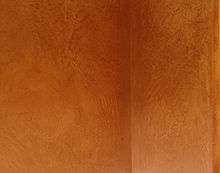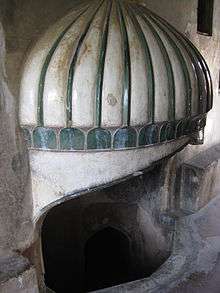Tadelakt


Tadelakt (tadla:kt) is a waterproof plaster surface used in Moroccan architecture to make baths, sinks, water vessels, interior and exterior walls, ceilings, roofs, and even floors. It is made from lime plaster, which is rammed, polished, and treated with soap to make it waterproof and water-repellant.[1] Tadelakt is labour-intensive to install, but durable.[2] Since it is applied as a paste, tadelakt has a soft, undulating character, it can form curves, and it is seamless. Pigment can be added to give it any colour, but deep red is traditional.[3] It may have a shiny or matte finish.
Etymology and history
"Tadelakt" means "to rub in", from Amazigh/Berber.[3]
Tadelakt is thought to have evolved from qadad, a similar plaster treated with calcium hydroxide and oils and fats instead of soaps.[2]
Constituents and chemistry
The basic constituents of tadelakt plaster are:
- lime plaster (not Portland cement)
- in some cases, marble or limestone sand (but not other aggregates)
- natural soap (often "black" or olive oil soap) to speed carbonation of the surface and impart water-resistance.
The soap chemically reacts with the lime plaster, forming lime (calcium) soaps. Calcium soaps are insoluble in water,[4] and fairly hard.[3] They are familiar, in areas with calcium-rich ("hard") water, as deposits in bathtubs, sinks, and showers; when soap is mixed with the water's dissolved calcium carbonate/lime, calcium soaps form.
- 2 C17H35COO−Na+ + Ca2+ → (C17H35COO)2Ca + 2 Na+
Techniques

Traditional application includes polishing with a river stone and treatment with oleic acid, in the form of olive oil soap, to lend it its final appearance and water resistance.
In Morocco, the traditional application technique:
- plaster powder is mixed with water for 12 to 15 hours prior to the addition of pigment.
- the plaster is applied in one thick coat with a wooden float, and smoothed with the same.
- before the plaster sets, a flat, smooth, hard stone is used to compress the plaster, then a plastic trowel used for the final polish.
- it is mechanically polished using stones or abrasives harder than the plaster, providing a smooth, sometimes shiny, finish.
- lastly, an olive-oil soap solution is used to seal the plaster
Long-term maintenance of tadelakt requires regularly re-sealing the surface with a soap solution;[3] in the case of qadad roofs, this was traditionally done every few years.[2]
Tadelakt can be elaborately carved into yeseria.
Uses

Tadelakt is the traditional coating of the palaces, hammams and bathrooms of the riads in Morocco.[6] The restoration of the riads of Morocco had led to a resurgence in its use.
In modern times, it has been used outside.[7]
See also
References
- ↑ "Hydrophobized Lime Plasters as Protective Surface in Wet Rooms in Monument Preservation". Advanced Materials Research. 688: 60–69. doi:10.4028/www.scientific.net/AMR.688.60.
- 1 2 3 Anita Sutter, « Note sur la fabrication du qadâd », Chroniques yéménites [En ligne], 6-7 | 1999, mis en ligne le 18 décembre 2006, consulté le 13 février 2016. URL : http://cy.revues.org/111
- 1 2 3 4 Polak, Monique (1 September 2005). "Home Invasion". Orca Book Publishers – via Google Books.
- ↑ "Solubility of calcium soaps of long-chain fatty acids in simulated intestinal environment". Digestive Diseases and Sciences. 28: 733–736. doi:10.1007/BF01312564.
- ↑ "Recognised as one of the most Beautiful little Riads in the Marrakech Medina". www.laksiba.com.
- ↑ "Non-Destructive Prospection of Ancient Steam Bathes Covered with Tadelakt — First Preliminary Comparison of Hammam Kasbah des Caids of Tamnougalt and Hammam Kasbah of Taourirt, Morocco". Advanced Materials Research. 923: 174–182. doi:10.4028/www.scientific.net/AMR.923.174.
- ↑ "Tadelakt Exterior stucco Vancouver - Venetian Plaster and Stucco - Vancouver BC". authenticplasterfx.com.
External links


-Jerusalem-Temple_Mount-Dome_of_the_Rock_(SE_exposure).jpg)